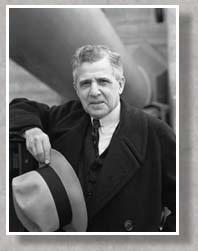
The idea of forming a special district of the State of California to construct the bridge was proposed by San Francisco City Engineer Michael O’Shaughnessy, Secretary to the Mayor of San Francisco Edward Rainey, and engineer Joseph B. Strauss. They believed a special district was necessary to oversee the financing, design and construction of the Bridge so that all counties affected would have a voice in the proceedings.
On January 13, 1923, an historic meeting (PDF of meeting agenda) was called by Franklin P. Doyle (link is to a PDF of Doyle “in memoriam” 1863 to 1948, from the District’s FY 1948/1949 Annual Report), a local Sonoma County banker and president of the Santa Rosa Chamber of Commerce. Out of this meeting, the Bridging the Golden Gate Association was formed and devoted its efforts to the promotion of a span across the Strait. The Association was dedicated to promoting the idea, through its “Bridge-the-Gate” campaign, throughout the northern California counties. The Association was also committed to obtaining legislation for carrying out the project.
Working with California State Assemblyman Frank L. Coombs of Napa and Marin County attorney George H. Harlan (click to read a biography), a specialist in the organization of tax districts, the Coombs Bill, enabling the creation of a special district—Bridge and Highway District—for the purpose of planning, designing, building and financing a bridge across the Strait, was signed into law on May 25, 1923.
The fate of the bridge idea was now in the hands of the War Department as only it could authorize construction as the owner of the land on either side of the Strait. Additionally, the War Department had jurisdiction over all harbor construction potentially affecting shipping traffic or military logistics. In May 1924, San Francisco and Marin counties made a joint application to the War Department for a permit to build a bridge. The War Department held a hearing on May 16, 1924, to discuss two issues: would the bridge hinder navigation and was adequate financing available. Because of overwhelming testimony in favor of the bridge project, Secretary of War John W. Weeks issued a provisional permit on December 20, 1924.
Strong opposition emerged quickly from well-financed special interests, particularly ferry companies. An aggressive campaign was launched to stop construction of a bridge and the formation of the special district as the entity to build the bridge. Eight years of opposition and litigation followed.
Joseph B. Strauss based himself at San Francisco’s Palace Hotel. He quickly became the most outspoken promoter of the span, spending the next few years leading and organizing petition drives to convince the individual counties from San Francisco to the Oregon border to join the new Bridge District. Under the Coombs Bill, all 21 northern California counties had the option to join or not join the Bridge and Highway District. When 10 percent of a county’s population agreed, by signing a petition, the petition was then submitted to the county board of supervisors who would then decide to join or not join the District. While many counties opted out, San Francisco, Marin, Sonoma, Del Norte and parts of Napa and Mendocino counties ultimately voted to form the Bridge and Highway District.
Mendocino County was the first to approve on January 7, 1925. Marin quickly followed on January 23. Sonoma and Napa counties were eager to join. In Humboldt County, lumbermen worried newcomers might agitate against cutting the redwoods. Cattlemen and sheep ranchers feared tourism would bring campers and hikers who interfere with their stock. Cost-conscious Lake County said “no.” San Francisco’s ordinance was introduced January 26. Supervisors held out for two months to gain more representation on the Bridge Board, and finally unanimously endorsed membership in the District on April 13. Finally, Del Norte voted its approval on August 24, 1925.
Subsequently, a vigorous campaign was launched against the formation of the District, and for nearly six years the formation of the District was dragged through the courts of the counties involved. Formal court hearings on protests against joining the District began October 1927. Fourteen months later, on December 1, 1928, Superior Court Judge C.J. Luttrell denied all 2307 protests. His decision was later upheld by the Supreme Court. Passage of Marin Assemblyman Charles Reindollar’s bill validated all legal steps to form the District. Secretary of State Frank Jordan signed the Certificate of Incorporation on December 4, 1928.
Bridge supporters prevailed, and on December 4, 1928, the Golden Gate Bridge and Highway District, comprised of its six member counties, was incorporated by the California State Legislature as the sole entity responsible for the final design, construction, and financing of a bridge.
Following the formal creation of the Bridge and Highway District, the Boards of Supervisors of the District’s six member counties appointed directors to the District’s Board of Directors (Board). The first meeting of the Board was held on January 23, 1929. William P. Filmer was the first Board President, with Alan MacDonald appointed as General Manager, John R. Ruckstell as Auditor, and William W. Felt, Jr. as Secretary, George H. Harlan as Attorney, and Joseph B. Strauss as Chief Engineer.
Secretary of War Patrick Hurley issued the construction permit August 11, 1930.
The Chief Engineer of the Golden Gate Bridge, Joseph B. Strauss, with the assistance of Strauss Engineering (later to become Strauss and Paine, Inc.) Vice Presidents Charles A. Ellis and Clifford E. Paine, Consultant Engineers O.H. Ammann, Charles Derleth, Jr. and Leon S. Moisseiff, Consulting Architects Irving F. Morrow, along with many dedicated workers and professionals, oversaw the creation of a structure which has become world-renowned, earning the reputation as the world's most spectacular Bridge and one of the most visited sites in the world.